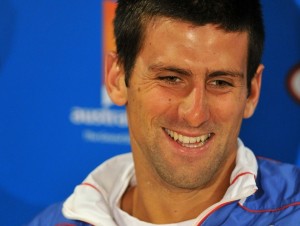Novak Djokovic looked tortured, as usual, even as he was serving for the match.
One miss, however close, and the lips tighten, the head tilts, the eyes say, “What a stupid shot,” and he looks as if he just opened a Christmas present and got another pair of socks instead of an electric train.
But when it was over and he had thumped Roger Federer, again, this time by 7-6 (3), 7-5, 6-4, there was the happy-child Djokovic parading around the court, gesturing his thanks to the fans on the Rod Laver court where so many good things have happened for him.

The Djoker is into the Australian Open final and Federer, for the fourth Grand Slam in a row, has failed to reach the championship round.
The TV wags were talking as if the “torch is being passed” because neither Nadal, who is only 23, nor Federer is in the final. But the Federer torch was passed months ago. What we’ve got now and for an extended future is a hugely competitive men’s tennis tour with Nadal and Djokovic front and center, with Juan Martin Del Potro slowly working back to top form after surgery and possibly, just possibly, Andy Murray.
Federer? At 29 his best years are behind him. Is he still a force at the majors? Of course. He continues to win the matches he’s supposed to win, but when he’s reached the semis, all the players he’s beaten in his prime and who have now fully matured, are his conquerors.
While he holds a head to head edge over Djokovic (13-7), he’s now lost twice in a row and three of the last four to Nole in majors. And that’s six consecutive sets for Novak over Federer on the Rod Laver court, where Djokovic won the 2008 Aussie Open.
When Djokovic’s head is screwed on properly, he’s the better player. He has the baseline quickness to deal with Federer’s aggressiveness. He has power off both sides. He takes Federer down in the backhand-to-backhand rallies. And (fingers are crossed) his serve, while not explosive, is consistently deep enough to give him control.
Why fingers crossed? Because less than a year ago, when his head was not correctly adjusted, Djokovic was going through service hell.
He had brought in Todd Martin, the former ATP top-10, to fix his serve, but, ultimately, that didn’t work. It wasn’t until three or four months into the 2010 season that he finally rediscovered his service rhythm, and it hasn’t abandoned him since.
“Yeah, yeah. I know. It has changed. The problem is that there’s too many things, and too many people saying a lot of things. It all affects me mentally,” Djokovic had complained early in 2010 as he struggled through to a title at Dubai.
“I’m still trying to get back to the old serve,” he went on. “It takes time. But when you’re playing matches day after day and you don’t have time one day to relax and focus on the practice and the serve . . .” His voice trailed off. Classic Djokovic confusion.
But he insisted then that it was not a big problem — just mental. And he was right. When he had a chance to breathe deeply, to settle down, it all came back, and it was on display in this Federer win.
The loss to Jo-Wilfried Tsonga in the quarters of last year’s Aussie Open, where he had just two aces and nine double faults, was ancient history. His 11 double faults in a humiliating loss to Olivier Rochus in his opening round at Key Biscayne last year is now a distant memory.
At this Aussie Open, he has stroked 46 aces and 14 doubles in six matches. He doesn’t crush 20 aces a match, like Andy Roddick. But his location is excellent, leaving him easy opportunities to take control of points off his first ground stroke, and — most important — he gets in a high percentage of first serves.
In six matches at Melbourne, Djokovic’s first-serve-in percentage: 67%, 65%, 77%, 75%, 68%, 69%.
Please note that final figure vs. Federer. He placed seven of every 10 first serves in the box and won three of every four of those points. Against one of the best service returners in the game, Djokovic was busted only three times.
No discussion of this Djokovic win would be complete without mentioning one of the most under-appreciated aspects of his game — his service returning.
When Djokovic beat Federer in five in last year’s U.S. Open semis, Federer had just 12 aces in 25 service games. When Federer defeated Djokovic in the 2009 U.S. Open final, he had just eight aces in 18 service games.
And on Thursday in Melbourne, as Djokovic sent Roger reeling out of a major for the fourth time in a row before the final round, Federer had just five aces in 17 games, and just one each in the final two sets.
The impact of that cannot be mistaken. When Djokovic gets the serve back into play, he’s at least on an equal footing with anyone most of the time, and that should be enough to carry him and his well-adjusted head, to another Grand Slam title.
